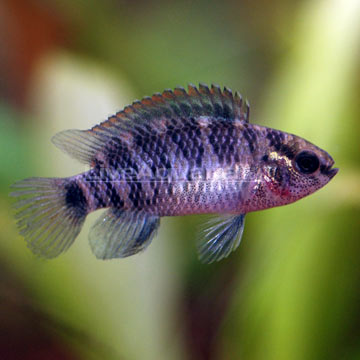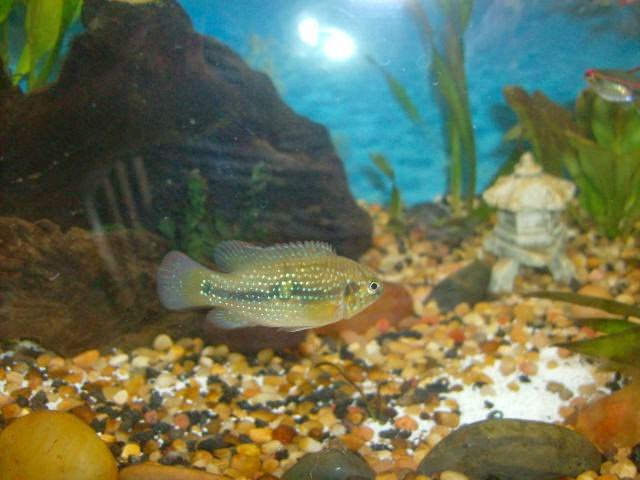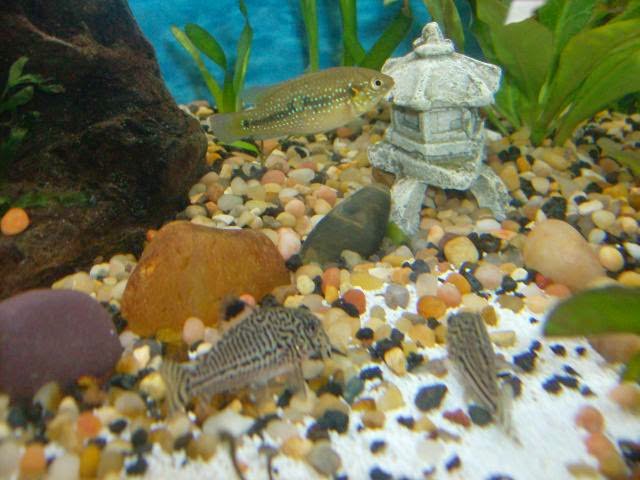Byron Amazonas
AC Members
To provide some more general info on the Badids, another work of mine on this group of fish:
Badids
The Badidae is a small family of fish in the order Perciformes. The name Perciformes is derived from the Greek perke [perch] and the Latin forma [shape]. The order contains approximately 40% of all bony fish and is the largest order among all the vertebrates; it is also the most variably sized order, having members as small as 7 millimetres (just over ¼ inch) to as large as 5 metres (16.4 feet). They first appeared and diversified in the late Cretaceous period. There are 156 families in 18 sub-orders; most of the more than 7,000 species of perciformes are marine shore fish, including about 2,200 species that occur in freshwater for part of their lives. Approximately 2,000 species are strictly freshwater fish, including the cichlids, bass and perch, anabantids, nandids and badids.
The family Badidae was erected in 1968 by George Barlow, Karel Liem and Wolfgang Wickler for the sole species now known as Badis badis. This fish had originally been described by Hamilton in 1822 and placed in the marine genus Labrus [along with a closely-related fish now known as Dario dario]. In 1854 Bleeker erected the genus Badis within the freshwater family Nandidae (the leaffishes) for Badis badis on the basis of osteological characteristics that made the species distinct from other Nandidae species.
In 2002 a major revision of the Badidae was made by Kullander et.al. and 10 new species were described. A new genus, Dario, was erected, with Dario dario as the neotype and two newly described species, D. dayingensis and D. hysginon, were included. The genus Badis was divided into five clades and at the time of writing there are 14 Badis species listed in Fishbase.
Badids share some characteristics with Anabantids, Nandids and Channids. From the aquarist’s perspective, the male embrace of the female during spawning is shared by both anabantids and badids.
The nandids and badids differ only in morphology and egg structure, although the phylogenetic relationships among the species and species groups are not fully resolved (Ruber et.al. 2004). Badis apparently split off from the ancestral anabantoids before they acquired the air-breathing adaptation. The osteological differences between Badis and the anabantoids stem chiefly from the modifications accompanying aerial respiration.
The egg of badids is enclosed in an unusually tough sheath that is extremely adhesive. The egg itself lacks any special device for attaching. The larva has an adhesive organ at the tip of the yolk sac. The egg and the larva of badids are thus unique among teleosts insofar as is known (Barlow et.al. 1968).
Badids have no teeth but do possess an ectopterygoid, a membrane bone located ventrally on the skull, situated behind the palate and extending to the quadrate.
All species normally inhabit small streams or hill streams with low to moderate flow, coastal drainages, or ditches with stagnant water. They are lurking predators feeding on small invertebrates. The badidae are distributed throughout the lowlands of the Ganges, Brahmaputra and Mahanadi basins, in Nepal, India and Bangladesh; Pakistan, peninsular Thailand, and the Upper Irrawaddy in Myanmar and China (Dario species).
This family includes the smallest known percoid fish, Dario dario, at a standard length of less than 20mm.
References:
Barlow, George W., Karel F. Liem and Wolfgang Wickler (1968), "Badidae, a new fish family--behavioural, osteological, and developmental evidence," Journal of Zoology 156 (4), pp. 415-447.
Kullander, Sven O. & R. Britz (2002), "Revision of the Family Badidae (Teleostei: Perciformes), with description of a new genus and ten new species," Ichthyological Exploration of Freshwaters 13(4), pp. 295-372.
Ruber, Lucas, Ralf Britz, Sven O. Kullander & Rafael Zardoya (2004), “Evolutionary and biogeographic patterns of the Badidae (Teleostei: Perciformes) inferred from mitochondrial and nuclear DNA sequence data,” Molecular Phylogenetics and Evolution 32 (3), Sep 2004, pp. 1010-1022.
Badids
The Badidae is a small family of fish in the order Perciformes. The name Perciformes is derived from the Greek perke [perch] and the Latin forma [shape]. The order contains approximately 40% of all bony fish and is the largest order among all the vertebrates; it is also the most variably sized order, having members as small as 7 millimetres (just over ¼ inch) to as large as 5 metres (16.4 feet). They first appeared and diversified in the late Cretaceous period. There are 156 families in 18 sub-orders; most of the more than 7,000 species of perciformes are marine shore fish, including about 2,200 species that occur in freshwater for part of their lives. Approximately 2,000 species are strictly freshwater fish, including the cichlids, bass and perch, anabantids, nandids and badids.
The family Badidae was erected in 1968 by George Barlow, Karel Liem and Wolfgang Wickler for the sole species now known as Badis badis. This fish had originally been described by Hamilton in 1822 and placed in the marine genus Labrus [along with a closely-related fish now known as Dario dario]. In 1854 Bleeker erected the genus Badis within the freshwater family Nandidae (the leaffishes) for Badis badis on the basis of osteological characteristics that made the species distinct from other Nandidae species.
In 2002 a major revision of the Badidae was made by Kullander et.al. and 10 new species were described. A new genus, Dario, was erected, with Dario dario as the neotype and two newly described species, D. dayingensis and D. hysginon, were included. The genus Badis was divided into five clades and at the time of writing there are 14 Badis species listed in Fishbase.
Badids share some characteristics with Anabantids, Nandids and Channids. From the aquarist’s perspective, the male embrace of the female during spawning is shared by both anabantids and badids.
The nandids and badids differ only in morphology and egg structure, although the phylogenetic relationships among the species and species groups are not fully resolved (Ruber et.al. 2004). Badis apparently split off from the ancestral anabantoids before they acquired the air-breathing adaptation. The osteological differences between Badis and the anabantoids stem chiefly from the modifications accompanying aerial respiration.
The egg of badids is enclosed in an unusually tough sheath that is extremely adhesive. The egg itself lacks any special device for attaching. The larva has an adhesive organ at the tip of the yolk sac. The egg and the larva of badids are thus unique among teleosts insofar as is known (Barlow et.al. 1968).
Badids have no teeth but do possess an ectopterygoid, a membrane bone located ventrally on the skull, situated behind the palate and extending to the quadrate.
All species normally inhabit small streams or hill streams with low to moderate flow, coastal drainages, or ditches with stagnant water. They are lurking predators feeding on small invertebrates. The badidae are distributed throughout the lowlands of the Ganges, Brahmaputra and Mahanadi basins, in Nepal, India and Bangladesh; Pakistan, peninsular Thailand, and the Upper Irrawaddy in Myanmar and China (Dario species).
This family includes the smallest known percoid fish, Dario dario, at a standard length of less than 20mm.
References:
Barlow, George W., Karel F. Liem and Wolfgang Wickler (1968), "Badidae, a new fish family--behavioural, osteological, and developmental evidence," Journal of Zoology 156 (4), pp. 415-447.
Kullander, Sven O. & R. Britz (2002), "Revision of the Family Badidae (Teleostei: Perciformes), with description of a new genus and ten new species," Ichthyological Exploration of Freshwaters 13(4), pp. 295-372.
Ruber, Lucas, Ralf Britz, Sven O. Kullander & Rafael Zardoya (2004), “Evolutionary and biogeographic patterns of the Badidae (Teleostei: Perciformes) inferred from mitochondrial and nuclear DNA sequence data,” Molecular Phylogenetics and Evolution 32 (3), Sep 2004, pp. 1010-1022.





